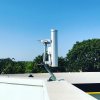I think
@alastairstevenson is hitting the nail on the head.
Consider:
We've still not measured the output voltages from any single camera by itself.
The meager documentation states that the alarm output is "12V 300mA". That doesn't tell us what the outputs really do. But to me, the fact that they don't give a range, or upper limit for the positive voltage, implies that this is NOT an open collector output. If it was an open collector to ground, they'd give a maximum current and a maximum voltage that this output transistor could handle. Sort of like giving some of the specifications for an NPN transistor (max collector current and max collector voltage, since it would be the collector that would be tied to the "alarm" output lead for the camera).
I still don't think it was ever the relay that was causing the problem or else the solid state relay would either make no difference or would make the latching worse. The inductive kick from the mechanical relay is not present now with the solid state relays. So it must be paralleling the alarm leads that's causing problems at this point.
If I was there, I'd separate one camera's alarm output from everything else. Then I'd measure the voltage with respect to ground on its alarm lead both triggered and untriggered.
In the untriggered state, I'd want to find out if the output is trying to sink to ground versus just going "open circuit", and this will take a bit more effort (but not much, really). And this testing will pay off by letting us know if the output can pull both directions or only one.
Just to start, I'd get a 1000 ohm resistor and a clip lead. I'd cut the clip lead in half and solder the resistor in so that you've got a "1000 ohm clip lead". A simple test light would also work, but this will work with your voltmeter and tell us a bit about saturation voltages.
Now, connect one end of the clip lead to each of your volt meter's probes. You've now got a voltmeter with a low (1000 Ohm) input impedance instead of the usual 10 megohms.
With the alarm untriggered, using this rig, measure the voltage at this isolated (not tied to anything else) alarm lead from ground. Then measure that voltage with respect to your 12V supply's + output. (This assumes that your 12V supply still has its common tied to the camera's ground and is powered up).
Now make those same two measurements with the camera triggered.
You can make a chart showing the voltages for each of these measurements (four measurements total).
Alarm Lead Triggered with respect to ground with 1000 Ohms Load
Alarm Lead Untriggered with respect to ground with 1000 Ohms Load
Alarm Lead Triggered with respect to +12V with 1000 Ohms Load
Alarm Lead Untriggered with respect to +12 with 1000 Ohms Load
With this, we can see exactly what the camera's alarm output is trying to do. At least with about a 12mA load on it.
If the camera's output is meant to be a "logic" output, and pull both high and low (like a CMOS output or a TTL "totem-pole" output), then you cannot just wire the camera's alarm outputs in parallel.
Doing so will cause the cameras to "fight", with one trying to pull high while the other is pulling low. And we have no idea what mayhem this will create within the cameras.
If they are capable of pulling both high and low, then we also need to know when they pull high and when they pull low. Do they pull high when triggered, or do they pull low? Presumably, they pull low when triggered, but I'd want to check and know for sure.
I wouldn't worry about pulling any new wire or doing anything until we establish exactly what the cameras' outputs really do. We may never know what the actual circuitry is, but we can work around that as long as we understand what the outputs are trying to do.
Do those tests on one lone camera, establishing exactly what the outputs try to do, and then we'll know exactly how to wire things up. It might only require using the "diode OR" wiring I described earlier, or some variation on that. In any case, I think it will be simple and not require pulling any new wires.










